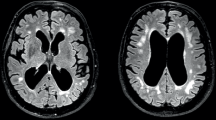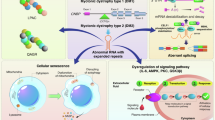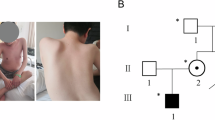Abstract
The myotonic dystrophies (DMs) are the most common inherited muscular disorders in adults. In most of the cases, the disease is caused by (CTG)n/(CCTG)n repeat expansions (EXPs) in non-coding regions of the genes DMPK (dystrophia myotonica-protein kinase) and CNBP (CCHC-type zinc-finger nucleic acid-binding protein). The EXP is transcribed into mutant RNAs, which provoke a common pathomechanism that is characterized by misexpression and mis-splicing. In this study, we screened 138 patients with typical clinical features of DM being negative for EXP in the known genes. We sequenced DMPK and CNBP – associated with DM, as well as CELF1 (CUGBP, Elav-like family member 1) and MBNL1 (muscleblind-like splicing regulator 1) – associated with the pathomechanism of DM, for pathogenic variants, addressing the question whether defects in other genes could cause a DM-like phenotype. We identified variants in three unrelated patients in the MBNL1 gene, two of them were heterozygous missense mutations and one an in-frame deletion of three amino acids. The variants were located in different conserved regions of the protein. The missense mutations were classified as potentially pathogenic by prediction tools. Analysis of MBNL1 splice target genes was carried out for one of the patients using RNA from peripheral blood leukocytes (PBL). Analysis of six genes known to show mis-splicing in the skeletal muscle gave no informative results on the effect of this variant when tested in PBL. The association of these variants with the DM phenotype therefore remains unconfirmed, but we hope that in view of the key role of MBNL1 in DM pathogenesis our observations may foster further studies in this direction.
Similar content being viewed by others
Log in or create a free account to read this content
Gain free access to this article, as well as selected content from this journal and more on nature.com
or
References
Udd B, Meola G, Krahe R et al: 140th ENMC International Workshop: myotonic dystrophy DM2/PROMM and other myotonic dystrophies with guidelines on management. Neuromuscl Disord 2006; 16: 403–413.
Harper PS : Major Problems in Neurology: Myotonic Dystrophy, 3rd edn. WB Saunders: London, UK, 2001.
Ricker K, Koch MC, Lehmann-Horn F et al: Proximal myotonic myopathy: a new dominant disorder with myotonia, muscle weakness, and cataracts. Neurology 1994; 44: 1448–1452.
Brook JD, McCurrach ME, Harley HG et al: Molecular basis of myotonic dystrophy: expansion of a trinucleotide (CTG) repeat at the 3' end of a transcript encoding a protein kinase family member. Cell 1992; 68: 799–808.
Fu YH, Pizzuti A, Fenwick RG Jr et al: An unstable triplet repeat in a gene related to myotonic muscular dystrophy. Science 1992; 255: 1256–1258.
Mahadevan M, Tsilfidis C, Sabourin L et al: Myotonic dystrophy mutation: an unstable CTG repeat in the 3' untranslated region of the gene. Science 1992; 255: 1253–1255.
Ranum LP, Rasmussen PF, Benzow KA, Koob MD, Day JW : Genetic mapping of a second myotonic dystrophy locus. Nature genetics 1998; 19: 196–198.
Liquori CL, Ricker K, Moseley ML et al: Myotonic dystrophy type 2 caused by a CCTG expansion in intron 1 of ZNF9. Science 2001; 293: 864–867.
Hunter A, Tsilfidis C, Mettler G et al: The correlation of age of onset with CTG trinucleotide repeat amplification in myotonic dystrophy. J Med Genet 1992; 29: 774–779.
Thornton CA, Johnson K, Moxley RT III : Myotonic dystrophy patients have larger CTG expansions in skeletal muscle than in leukocytes. Ann Neurol 1994; 35: 104–107.
Taneja KL, McCurrach M, Schalling M, Housman D, Singer RH : Foci of trinucleotide repeat transcripts in nuclei of myotonic dystrophy cells and tissues. J Cell Biol 1995; 128: 995–1002.
Miller JW, Urbinati CR, Teng-Umnuay P et al: Recruitment of human muscleblind proteins to (CUG)(n expansions associated with myotonic dystrophy. EMBO J 2000; 19: 4439–4448.
Ranum LP, Cooper TA : RNA-mediated neuromuscular disorders. Annu Rev Neurosci 2006; 29: 259–277.
Timchenko LT, Miller JW, Timchenko NA et al: Identification of a (CUG)n triplet repeat RNA-binding protein and its expression in myotonic dystrophy. Nucleic Acids Res 1996; 24: 4407–4414.
Philips AV, Timchenko LT, Cooper TA : Disruption of splicing regulated by a CUG-binding protein in myotonic dystrophy. Science 1998; 280: 737–741.
Jiang H, Mankodi A, Swanson MS, Moxley RT, Thornton CA : Myotonic dystrophy type 1 is associated with nuclear foci of mutant RNA, sequestration of muscleblind proteins and deregulated alternative splicing in neurons. Hum Mol Genet 2004; 13: 3079–3088.
Timchenko NA, Patel R, Iakova P, Cai ZJ, Quan L, Timchenko LT : Overexpression of CUG triplet repeat-binding protein, CUGBP1, in mice inhibits myogenesis. J Biol Chem 2004; 279: 13129–13139.
Kanadia RN, Johnstone KA, Mankodi A et al: A muscleblind knockout model for myotonic dystrophy. Science 2003; 302: 1978–1980.
Ladd AN, Charlet N, Cooper TA : The CELF family of RNA binding proteins is implicated in cell-specific and developmentally regulated alternative splicing. Mol Cell Biol 2001; 21: 1285–1296.
Kalsotra A, Xiao X, Ward AJ et al: A postnatal switch of CELF and MBNL proteins reprograms alternative splicing in the developing heart. Proc Natl Acad Sci USA 2008; 105: 20333–20338.
Kim YK, Mandal M, Yadava RS, Paillard L, Mahadevan MS : Evaluating the effects of CELF1 deficiency in a mouse model of RNA toxicity. Hum Mol Genet 2014; 23: 293–302.
Ho TH, Bundman D, Armstrong DL, Cooper TA : Transgenic mice expressing CUG-BP1 reproduce splicing mis-regulation observed in myotonic dystrophy. Hum Mol Genet 2005; 14: 1539–1547.
Lin X, Miller JW, Mankodi A et al: Failure of MBNL1-dependent post-natal splicing transitions in myotonic dystrophy. Hum Mol Genet 2006; 15: 2087–2097.
Moxley RT 3rd : 54th ENMC International Workshop: PROMM (proximal myotonic myopathies) and other proximal myotonic syndromes. 10–12th October 1997, Naarden, The Netherlands. Neuromuscl Disord 1998; 8: 508–518.
Margulies M, Egholm M, Altman WE et al: Genome sequencing in microfabricated high-density picolitre reactors. Nature 2005; 437: 376–380.
Moonsamy PV, Williams T, Bonella P et al: High throughput HLA genotyping using 454 sequencing and the Fluidigm Access Array System for simplified amplicon library preparation. Tissue Antigens 2013; 81: 141–149.
Ng PC, Henikoff S : Predicting deleterious amino acid substitutions. Genome Res 2001; 11: 863–874.
Adzhubei IA, Schmidt S, Peshkin L et al: A method and server for predicting damaging missense mutations. Nat Methods 2010; 7: 248–249.
Schwarz JM, Rodelsperger C, Schuelke M, Seelow D : MutationTaster evaluates disease-causing potential of sequence alterations. Nat Methods 2010; 7: 575–576.
Jog SP, Paul S, Dansithong W, Tring S, Comai L, Reddy S : RNA splicing is responsive to MBNL1 dose. PLoS One 2012; 7: e48825.
Kimura T, Nakamori M, Lueck JD et al: Altered mRNA splicing of the skeletal muscle ryanodine receptor and sarcoplasmic/endoplasmic reticulum Ca2+-ATPase in myotonic dystrophy type 1. Hum Mol Genet 2005; 14: 2189–2200.
Du H, Cline MS, Osborne RJ et al: Aberrant alternative splicing and extracellular matrix gene expression in mouse models of myotonic dystrophy. Nat Struct Mol Biol 2010; 17: 187–193.
Teplova M, Patel DJ : Structural insights into RNA recognition by the alternative-splicing regulator muscleblind-like MBNL1. Nat Struct Mol Biol 2008; 15: 1343–1351.
Cass D, Hotchko R, Barber P, Jones K, Gates DP, Berglund JA : The four Zn fingers of MBNL1 provide a flexible platform for recognition of its RNA binding elements. BMC Mol Biol 2011; 12: 20.
Edge C, Gooding C, Smith CW : Dissecting domains necessary for activation and repression of splicing by Muscleblind-like protein 1. BMC Mol Biol 2013; 14: 29.
Biasini M, Bienert S, Waterhouse A et al: SWISS-MODEL: modelling protein tertiary and quaternary structure using evolutionary information. Nucleic Acids Res 2014; 42: W252–W258.
Yuan Y, Compton SA, Sobczak K et al: Muscleblind-like 1 interacts with RNA hairpins in splicing target and pathogenic RNAs. Nucleic Acids Res 2007; 35: 5474–5486.
Meola G, Cardani R : Myotonic dystrophies: an update on clinical aspects, genetic, pathology, and molecular pathomechanisms. Biochim Biophys Acta 2015; 1852: 594–606.
Osborne RJ, Lin X, Welle S et al: Transcriptional and post-transcriptional impact of toxic RNA in myotonic dystrophy. Hum Mol Genet 2009; 18: 1471–1481.
Bachinski LL, Baggerly KA, Neubauer VL et al: Most expression and splicing changes in myotonic dystrophy type 1 and type 2 skeletal muscle are shared with other muscular dystrophies. Neuromuscl Disord 2014; 24: 227–240.
Acknowledgements
We are deeply grateful to all patients for their participation in this study. We thank Alexander Keller for modeling of the protein structure.
Author information
Authors and Affiliations
Corresponding author
Ethics declarations
Competing interests
The authors declare no conflict of interest.
Additional information
Supplementary Information accompanies this paper on European Journal of Human Genetics website
Supplementary information
Rights and permissions
About this article
Cite this article
Larsen, M., Kress, W., Schoser, B. et al. Identification of variants in MBNL1 in patients with a myotonic dystrophy-like phenotype. Eur J Hum Genet 24, 1467–1472 (2016). https://doi.org/10.1038/ejhg.2016.41
Received:
Revised:
Accepted:
Published:
Issue date:
DOI: https://doi.org/10.1038/ejhg.2016.41
This article is cited by
-
Curriculum vitae of CUG binding protein 1 (CELF1) in homeostasis and diseases: a systematic review
Cellular & Molecular Biology Letters (2024)
-
Establishment of quantitative and consistent in vitro skeletal muscle pathological models of myotonic dystrophy type 1 using patient-derived iPSCs
Scientific Reports (2023)



